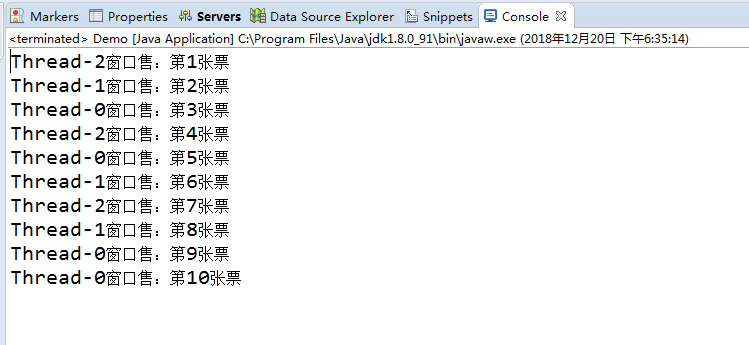201771010123汪慧和《面向对象程序设计Java》第十七周实验总结
一、理论部分
1、多线程并发执行中的问题
◆多个线程相对执行的顺序是不确定的。
◆线程执行顺序的不确定性会产生执行结果的不确定性。
◆在多线程对共享数据操作时常常会产生这种不确定性。
2、线程的同步
-多线程并发运行不确定性问题解决方案:引入线程同步机制,使得另一线程要使用该方法,就只能等待。
- 在Java中解决多线程同步问题的方法有两种:
- Java SE 5.0中引入ReentrantLock类
- 在共享内存的类方法前加synchronized修饰符。
……
public synchronized static void sub(int m)
……
(1)解决方案一:锁对象与条件对象
用ReentrantLock保护代码块的基本结构如下:
myLock.lock();
try {
critical section
}
finally
{
myLock.unlock();
}
有关锁对象和条件对象的关键要点:
➢ 锁用来保护代码片段,保证任何时刻只能有一个线程执行被保护的代码。
➢ 锁管理试图进入被保护代码段的线程。
➢ 锁可拥有一个或多个相关条件对象。
➢ 每个条件对象管理那些已经进入被保护的代码段但还不能运行的线程。
(2)解决方案二: synchronized关键字
synchronized关键字作用:
➢某个类内方法用synchronized 修饰后,该方法被称为同步方法;
➢只要某个线程正在访问同步方法,其他线程欲要访问同步方法就被阻塞,直至线程从同步方法返回前唤醒被阻塞线程,其他线程方可能进入同步方法。
3、在同步方法中使用wait()、notify 和notifyAll()方法
➢ 一个线程在使用的同步方法中时,可能根据问题的需要,必须使用wait()方法使本线程等待,暂时让出CPU的使用权,并允许其它线程使用这个同步方法。
➢ 线程如果用完同步方法,应当执行notifyAll()方法通知所有由于使用这个同步方法而处于等待的线程结束等待。
二、实验部分
1、实验目的与要求
(1) 掌握线程同步的概念及实现技术;
(2) 线程综合编程练习
2、实验内容和步骤
实验1:测试程序并进行代码注释。
测试程序1:
l 在Elipse环境下调试教材651页程序14-7,结合程序运行结果理解程序;
l 掌握利用锁对象和条件对象实现的多线程同步技术。
package synch; import java.util.*; import java.util.concurrent.locks.*; /** * 一种拥有许多银行帐户的银行,它使用锁来序列化访问。 * @version 1.30 2004-08-01 * @author Cay Horstmann */ public class Bank { private final double[] accounts; private Lock bankLock; private Condition sufficientFunds; /** *构建了银行。 * @param 账户数量 * @param 每个账户的初始余额 */ public Bank(int n, double initialBalance) { accounts = new double[n]; Arrays.fill(accounts, initialBalance); bankLock = new ReentrantLock(); sufficientFunds = bankLock.newCondition(); } /** * 把钱从一个账户转到另一个账户。 * @param 从账户转出 * @param 到账转到 * @param 转帐金额 */ public void transfer(int from, int to, double amount) throws InterruptedException { bankLock.lock(); try { while (accounts[from] < amount) sufficientFunds.await();//注释掉之后产生死锁现象,都在等待 System.out.print(Thread.currentThread()); accounts[from] -= amount; System.out.printf(" %10.2f from %d to %d", amount, from, to); accounts[to] += amount; System.out.printf(" Total Balance: %10.2f%n", getTotalBalance()); sufficientFunds.signalAll();//注释掉之后产生死锁现象,都在等待 } finally { bankLock.unlock(); } } /** *获取所有帐户余额的总和。 * @return 总平衡 */ public double getTotalBalance()//为什么只需要加锁不需要设置对象?没有任何执行不下去的原因,就不需要条件对象。 { bankLock.lock(); try { double sum = 0; for (double a : accounts) sum += a; return sum; } finally { bankLock.unlock(); } } /** * 获取银行中的帐户编号。 * @return 账户数量 */ public int size() { return accounts.length; } }
package synch; /** * 这个程序展示了多线程如何安全地访问数据结构。 * @version 1.31 2015-06-21 * @author Cay Horstmann */ public class SynchBankTest { public static final int NACCOUNTS = 100; public static final double INITIAL_BALANCE = 1000; public static final double MAX_AMOUNT = 1000; public static final int DELAY = 10; public static void main(String[] args) { Bank bank = new Bank(NACCOUNTS, INITIAL_BALANCE); for (int i = 0; i < NACCOUNTS; i++) { int fromAccount = i; Runnable r = () -> { try { while (true) { int toAccount = (int) (bank.size() * Math.random()); double amount = MAX_AMOUNT * Math.random(); bank.transfer(fromAccount, toAccount, amount); Thread.sleep((int) (DELAY * Math.random())); } } catch (InterruptedException e) { } }; Thread t = new Thread(r); t.start(); } } }
实验结果如下图所示:

测试程序2:
l 在Elipse环境下调试教材655页程序14-8,结合程序运行结果理解程序;
l 掌握synchronized在多线程同步中的应用。
package synch2; import java.util.*; /** * 使用同步原语的具有多个银行帐户的银行 * @version 1.30 2004-08-01 * @author Cay Horstmann */ public class Bank { private final double[] accounts; /** * 构建了银行。 * @param 账户数量 * @param 每个账户的初始余额 */ public Bank(int n, double initialBalance) { accounts = new double[n]; Arrays.fill(accounts, initialBalance); } /** * 把钱从一个账户转到另一个账户。 * @param 从账户转出 * @param 到账转到 * @param 转帐金额 */ public synchronized void transfer(int from, int to, double amount) throws InterruptedException { while (accounts[from] < amount) wait();//Object类 System.out.print(Thread.currentThread()); accounts[from] -= amount; System.out.printf(" %10.2f from %d to %d", amount, from, to); accounts[to] += amount; System.out.printf(" Total Balance: %10.2f%n", getTotalBalance()); notifyAll(); } /** *获取所有帐户余额的总和。 * @return 总平衡 */ public synchronized double getTotalBalance() { double sum = 0; for (double a : accounts) sum += a; return sum; } /** * 获取银行中的帐户编号。 * @return 账户数量 */ public int size() { return accounts.length; } }
package synch2; /** * 这个程序展示了多线程如何安全地访问一个数据结构,使用同步方法。 * @version 1.31 2015-06-21 * @author Cay Horstmann */ public class SynchBankTest2 { public static final int NACCOUNTS = 100; public static final double INITIAL_BALANCE = 1000; public static final double MAX_AMOUNT = 1000; public static final int DELAY = 10; public static void main(String[] args) { Bank bank = new Bank(NACCOUNTS, INITIAL_BALANCE); for (int i = 0; i < NACCOUNTS; i++) { int fromAccount = i; Runnable r = () -> { try { while (true) { int toAccount = (int) (bank.size() * Math.random()); double amount = MAX_AMOUNT * Math.random(); bank.transfer(fromAccount, toAccount, amount); Thread.sleep((int) (DELAY * Math.random())); } } catch (InterruptedException e) { } }; Thread t = new Thread(r); t.start(); } } }
实验结果如下图所示:

测试程序3:
l 在Elipse环境下运行以下程序,结合程序运行结果分析程序存在问题;
l 尝试解决程序中存在问题。
|
class Cbank { private static int s=2000; public static void sub(int m) { int temp=s; temp=temp-m; try { Thread.sleep((int)(1000*Math.random())); } catch (InterruptedException e) { } s=temp; System.out.println("s="+s); } }
class Customer extends Thread { public void run() { for( int i=1; i<=4; i++) Cbank.sub(100); } } public class Thread3 { public static void main(String args[]) { Customer customer1 = new Customer(); Customer customer2 = new Customer(); customer1.start(); customer2.start(); } } |
存在问题:两个线程各做各的
实验结果如下图所示:

修改后的代码如下:
import javax.sql.rowset.spi.SyncFactory; class Cbank { private static int s=2000; public synchronized static void sub(int m) { int temp=s; temp=temp-m; try { Thread.sleep((int)(1000*Math.random())); } catch (InterruptedException e) { } s=temp; System.out.println("s="+s); } } class Customer extends Thread { public void run() { for( int i=1; i<=4; i++) Cbank.sub(100); } } public class Thread3 { public static void main(String args[]) { Customer customer1 = new Customer(); Customer customer2 = new Customer(); customer1.start(); customer2.start(); } }
实验结果如下图所示:

实验2 编程练习
利用多线程及同步方法,编写一个程序模拟火车票售票系统,共3个窗口,卖10张票,程序输出结果类似(程序输出不唯一,可以是其他类似结果)。
Thread-0窗口售:第1张票
Thread-0窗口售:第2张票
Thread-1窗口售:第3张票
Thread-2窗口售:第4张票
Thread-2窗口售:第5张票
Thread-1窗口售:第6张票
Thread-0窗口售:第7张票
Thread-2窗口售:第8张票
Thread-1窗口售:第9张票
Thread-0窗口售:第10张票
public class Demo { public static void main(String[] args) { Mythread mythread = new Mythread(); Thread ticket1 = new Thread(mythread); Thread ticket2 = new Thread(mythread); Thread ticket3 = new Thread(mythread); ticket1.start(); ticket2.start(); ticket3.start(); } } class Mythread implements Runnable { int ticket = 1; boolean flag = true; @Override public void run() { while (flag) { try { Thread.sleep(500); } catch (InterruptedException e) { // TODO Auto-generated catch block e.printStackTrace(); } synchronized (this) { if (ticket <= 10) { System.out.println(Thread.currentThread().getName() + "窗口售:第" + ticket + "张票"); ticket++; } if (ticket > 10) { flag = false; } } } } }
实验结果如下图所示:

三、实验总结
本周学习了同步线程的相关问题,了解了并发多线程的两种解决方法,一种是锁对象,还有一种是synchronized关键字。还有在同步方法中使用wait()、notify 和notifyAll()方法,使用wait()方法使本线程等待,暂时让出CPU的使用权,并允许其它线程使用这个同步方法。线程如果用完同步方法,应当执行notifyAll()方法通知所有由于使用这个同步方法而处于等待的线程结束等待。这周学习的收获很多,老师和学长讲解的东西基本都理解了。



